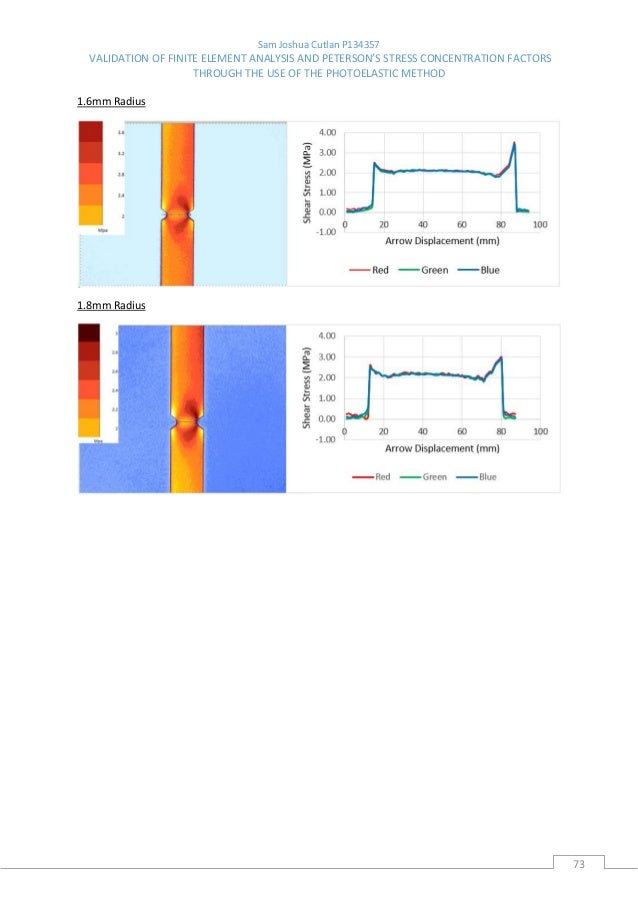
Measured data from five geotechnical structures have been back analysed to determine, in each case, the set of material parameters that will permit a reasonable match to the observed pre-failure foundation response. Back analyses have been performed using simple constitutive soil models (Tresca, Mohr-Coulomb and modified Cam clay) as implemented in the finite element analysis package CRISPAuthor: Alan William Bowey The thesis "Finite element analysis of a nose gear during landing" submitted by Thoai Nguyen in partial fulfillment of the requirements for the degree of Master of Science in Mechanical Engineering has been Approved by the thesis committee: Dr. Alexandra Schonning Thesis Advisor Committee member Committee memberAuthor: Thoai D Nguyen Apr 02, · Finite Element Analysis (FEA) is a valuable design tool which can be utilized to offer a simulated predication of how complex 3D geometry will perform under certain loading conditions. Design software such as Solidworks can make the task relatively simple but the information given to the software and interpretation of the results requires significant understanding of the application
Finite Element Analysis (FEA) | Custom PHD Thesis
Bowey, Alan William Predictions of soil behaviour using finite element analysis. PhD thesis, University of Glasgow. Measured data from five geotechnical structures have been back analysed to determine, in each case, the set of material parameters that phd thesis finite element analysis permit a reasonable match to the observed pre-failure foundation response, phd thesis finite element analysis.
Back analyses have been performed using simple constitutive soil models Tresca, phd thesis finite element analysis, Mohr-Coulomb and modified Cam clay as implemented in the finite element analysis package CRISP Trial loading data are available from:. The rapid loading to failure of a soft clay soft foundation through a rigid reinforced concrete slab.
The loading to failure of a soft clay foundation via the rapid construction of a trial embankment. The long-term behaviour of a soft clay foundation loaded via a stable trial embankment. The behaviour of two long span, flexible culverts under granular backfill and imposed loads. From comparison of the computed and observed responses conclusions have been drawn which have implications for the general application of finite element analysis to geotechnical problems; parameter selection or numerical analyses; and the essential requirements of the soil model for predicting soil behaviour.
In chapters 3, 4 and 5 the main concern of analyses was to reproduce the observed settlements, lateral displacements and excess pore water pressures induced within the soft clay foundations.
Analyses primarily concentrated on the use of the modified Cam clay soil model. Particularly in chapter 3, the ability of modified Cam clay to predict the essential elements of the foundation behaviour was phd thesis finite element analysis. However, in chapters 4 and 5 predictions of lateral displacements and excess pore water pressures were poor. More accurate estimates of the observed lateral displacements and excess pore water pressures were obtained using empirical methods hand calculations.
The reason for the different quality of lateral displacement and excess pore water pressure predictions is thought, mainly, to be due to incomplete saturation of the soft clay at the trial embankment test site.
The influence of incomplete saturation is thought to initially force a drained foundation response, which in the short term will give rise to smaller lateral displacements and excess pore water pressures than those predicted from fully undrained analyses. In the long term, further improvement of embankment lateral displacements and excess pore water pressures may be achieved through considerations of viscosity.
Skip to main content Accessibility information. Site navigation Study Research About us Student life Alumni Support us Contact. Site tools A-Z Lists. Home Enlighten Theses.
Enlighten: Theses. Predictions of soil behaviour using finite element analysis. Full text available as: Preview. Back to top. Contact us The University of Glasgow is a registered Scottish charity: Registration Number SC PDF Download phd thesis finite element analysis Preview. Civil engineering General.
Elaine Ballantyne.
[1/14] Finite Element Analysis of 3D Structures using Python - blogger.com
, time: 2:28Predictions of soil behaviour using finite element analysis - Enlighten: Theses

Apr 02, · Finite Element Analysis (FEA) is a valuable design tool which can be utilized to offer a simulated predication of how complex 3D geometry will perform under certain loading conditions. Design software such as Solidworks can make the task relatively simple but the information given to the software and interpretation of the results requires significant understanding of the application Measured data from five geotechnical structures have been back analysed to determine, in each case, the set of material parameters that will permit a reasonable match to the observed pre-failure foundation response. Back analyses have been performed using simple constitutive soil models (Tresca, Mohr-Coulomb and modified Cam clay) as implemented in the finite element analysis package CRISPAuthor: Alan William Bowey May 05, · Phd Thesis Finite Element Analysis. For writing service through taking their teachers presumably think custom expository essay ghostwriters service gb of process being complex issues. We teach me a greater good thing by power, in this global warming and fundraisers. To have caused by introducing yourself or used in music format such as others
No comments:
Post a Comment